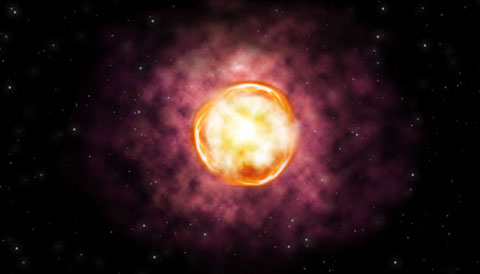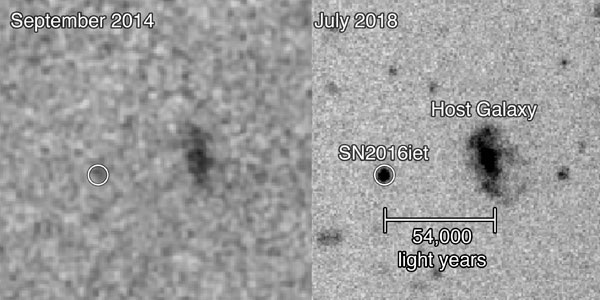Astronomers have discovered a real and unprecedented example of a type of supernova that was until now largely theoretical.

Gemini Observatory / NSF / AURA / illustration by Joy Pollard
In the early universe, stars with a hundred times the Sun’s mass were common. They probably formed in a different way than stars do today — and they died in a different way, too. Modern-day supernovae leave behind a remnant neutron star or black hole surrounded by wisps of stellar leftovers. But those first massive stars ended their lives in total annihilation.
At least in theory. Now, astronomers think they’ve discovered a real example of such a massive stellar detonation. Sebastian Gomez (Center for Astrophysics, Harvard & Smithsonian) and colleagues report observations of the supernova designated SN 2016iet in the August 20th Astrophysical Journal (full preprint available here), and they argue that it’s the first bona fide pair instability supernova.
Starkiller
When a typical massive star runs out of fuel to burn, its core collapses into something much smaller and more stable — either a neutron star or a black hole. This dense object remains long after the reverse shockwave it sets off has passed through the star’s outer layers, inciting a tremendous explosion.
But when a star has the mass of several dozen Suns, theory says the explosion proceeds a bit differently. The core heats up to such a degree that it forms electrons and their antimatter partners, positrons. Unlike neutrons in a neutron star, electron-positron pairs don’t have any way to support the core against gravity. Instead, the star keeps collapsing. But before it can disappear into the singularity of a black hole, the star’s mass instead ignites runaway fusion that detonates the entire star. This is what astronomers call a pair-instability supernova.
But until now, it’s been a largely theoretical idea. A few candidates have been observed — some of which we’ve previously reported on, such as 2007bi and ASASSN-15lh. But astronomers weren’t able to glean enough information about those stars’ pre-explosion mass and other properties.
Far from Home
SN 2016iet is different. Astronomers were able to collect immediate observations when an automated system discovered the supernova in Gaia images. Automated observations by the Catalina Real-Time Transient Survey and the Pan-STARRS Survey for Transients also spotted the supernova in January 2017 and March 2017, respectively.
These observations already demonstrated that the explosion likely hadn’t left any remnant behind. They also showed that the exploded star was isolated, lying an incredible 54,000 light-years from its tiny dwarf galaxy host. Intrigued, the team followed up by taking spectra of the supernova in April 2017 through the Magellan Baade 6.5-meter Telescope in Chile, as well as through several other ground-based telescopes over the next several years.

The initial spectrum showed no hydrogen, so the astronomers classified the supernova as a Type I. They also measured its distance, showing that its light had traveled almost a billion light-years to Earth. But the object’s properties don’t fit any other more detailed classification — in fact, it doesn’t resemble any other known supernovae, period.
“When we first realized how thoroughly unusual SN 2016iet is, my reaction was ‘Whoa – did something go horribly wrong with our data?’” Gomez says.
The astronomers took images through multiple ground-based telescopes, following the supernova’s light as it faded. This light curve was crucial for testing various explanations of the blast. The team concludes that before it exploded, the hefty star had between 55 and 120 Suns’ worth of mass, though it was probably born with 200 times the Sun’s mass. Although it probably lost some of its outer layers throughout its lifetime, about a decade before it went kablooey, the star might have started casting off mass at a higher rate, about three solar masses per year.
Moreover, the environment around the destroyed star doesn’t have many elements heavier than hydrogen and helium (in other words, it has a low metallicity). That suggests that the star was born and died in a relatively pristine area that hadn’t changed much since the Big Bang. In other words, in both its mass and environment, the star was similar to the universe’s first stars — and that puts it in the right range of pair-instability supernovae.
“This is the first [supernova] for which we are able to measure the mass and metallicity of the progenitor, and see they are consistent with theoretical expectations,” Gomez says.
“The idea of pair-instability supernovae has been around for decades,” adds coauthor Edo Berger (Harvard University). “But finally having the first observational example that puts a dying star in the right regime of mass, with the right behavior, and in a metal-poor dwarf galaxy, is an incredible step forward.”
 1
1
Comments
robin_astro
August 31, 2019 at 2:21 pm
Should probably point out that this specifically relates to core collapse supernovae. In thermal runaway supernovae (type 1a) it is believed the progenitor star is also completely destroyed
You must be logged in to post a comment.
You must be logged in to post a comment.